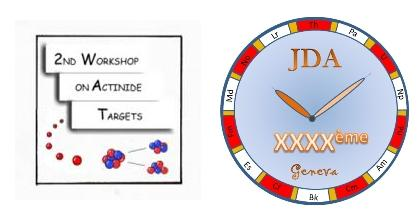Speaker
Yuriy Verbovytskyy
(Instituto Tecnológico e Nuclear)
Description
Crystallographic study of new phases from the U–Zn–Al ternary system
Yu.V. Verbovytskyy, A.P Gonçalves
Departamento de Química, Instituto Tecnológico e Nuclear/CFMC–UL, 2863–953 Sacavém, Portugal
yuryvv@bigmir.net
Uranium based intermetallic compounds have been intensively studied due to their unusual ground states and behaviours (as intermediate valence states, heavy fermion behaviours, unconventional superconductivity, etc.). The binary U–Zn system is characterised by the existence of two compounds, UZn12–x (high–temperature form of SmZn12) and U2Zn17 (crystallizing in two polymorphic modifications, with Th2Zn17 and Th2Ni17 structure types, respectively), which show coexistence of magnetism and heavy fermion behaviour [1,2]. Albeit this, the study of U–Zn–X (X = p element) ternary systems is still scarce. This work is a part of our systematic investigation of uranium – d– and p–metal alloy systems and consists on the exploration of the U–Zn–Al phase diagram and identification of the ternary compounds and solubility ranges.
The samples were synthesized at 950ºC from the pure elements, inside quartz ampoules under vacuum. No reaction with the quartz ampoules was observed. The obtained products were characterized by using X–ray powder diffraction techniques. Needle–shape high quality crystals were selected from crushed samples with nominal ~U10Zn60Al30 composition and used in the X–ray diffraction measurements. The experiments were made at room temperature by using a four–circle Nonius CAD4 diffractometer with graphite monochromatized Mo Kα–radiation and a scintillation counter with pulse height discrimination. Scans were taken in the ω/2θ mode. Empirical absorption corrections were applied on the basis of Ψ–scan data. The crystal structure was refined using Shelxl–97 [3] (full–matrix least–squares on F2). The unit cell parameters were obtained by least–squares refinement of the 2θ values of 25 intense and well–centered reflections from various parts of the reciprocal space (16°<2θ<36°).
The X–ray powder diffraction data of the as–prepared ~U10Zn60Al30 sample shows the presence of three phases: Zn1–xAlx (Mg–type), binary UAl3 (AuCu3–type) and hexagonal phase Ux(Zn1–yAly)z, with cell dimensional: a = 9.047(1) Å, c = 8.858(1) Å, V = 627.9(1) Å3. The cell dimensions fitting, from the 25 reflections and performed for several single crystals, gave always similar results: a ~9.03 Å, c ~8.82 Å, V ~622 Å3. After testing various models for well–known structures of binary R–Zn and ternary R–Zn–X compounds (R = rare earth), our attention was stopped on the high–temperature form of SmZn12 type structure (space group P6/mmm). In a first stage this structure type was adopted in the Ux(Zn1–yAly)z structural refinement from the single crystal X–ray diffraction data and residuals R1 = 0.0642, Rw = 0.1154 (405 F2 values, 41 variables) were obtained. The composition of this hexagonal phase was also refined, being obtained ~U1.12Zn9.51Al1.71 (=U9Zn77Al14). However, quite high residual factors still remain, which could indicate that the structure of the above mentioned phase was not exactly of the SmZn12 type, but some derived from it. In a second step direct methods were used and the Ux(Zn1–yAly)z crystal structure was determined and refined.
Acknowledgments
This work was partially supported by FCT, Portugal, under the contract No. PTDC/QUI/65369/2006 and No. SFRH/BPD/34840/2007.
References
[1] P. Chiotti and J.T. Mason. J. Less–Common Metals 40 (1975) 39.
[2] H.R. Ott, H. Rudigier, P. Delsing and Z. Fisk. Phys. Rev. Lett. 52 (1984) 1551.
[3] G.M. Sheldrick. SHELX97– A Program Package for the Solution and Refinement of Crystal Structures Universität Göttingen, Germany, 1997.
Primary author
Yuriy Verbovytskyy
(Instituto Tecnológico e Nuclear)




